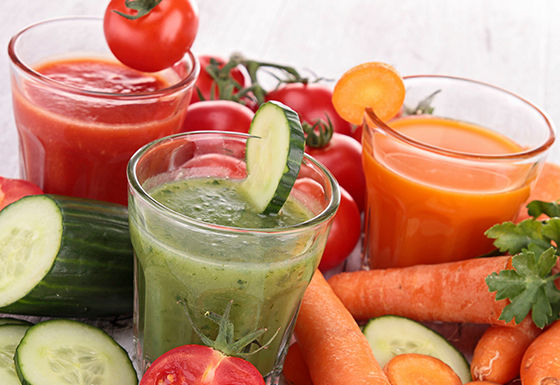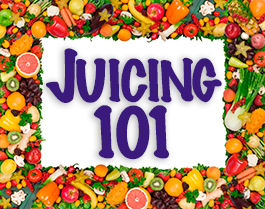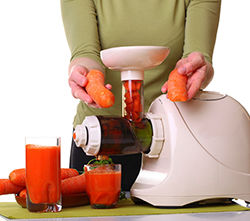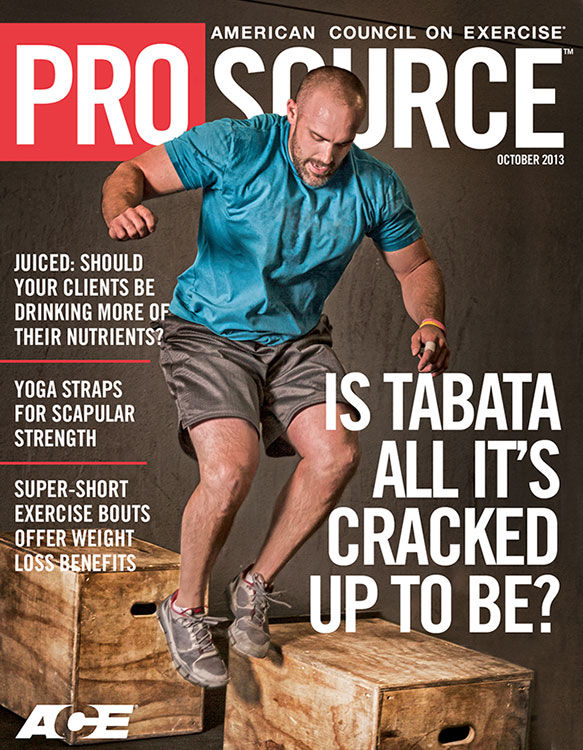
If you’ve always subscribed to the notion that you should eat your fruits and veggies, it’s time to get with the times. Many people now prefer getting their produce from a bottle, and we’re not just talking about good old orange juice. Today’s juices include “exotic” ingredients like kale, Swiss chard, ginger, dandelion and lemon juice, to name a few, and they’re hot—so hot, in fact, that you almost wonder if fruits and veggies will one day go the route of typewriters and pay phones, becoming so obsolete that kids in the future won’t even know they once existed.
Granted, that might be a slight exaggeration, but there’s little doubt that juicing has reached a fever pitch. It seems like everybody and their Aunt Sally are juicing these days, perhaps following in the footsteps of Hollywood celebrities who have touted juice fasts— not just juicing—as a surefire way to detox and slim down. Why eat your food, after all, when you can just sip your way to better health?
That, of course, is the burning question. Yet while juicing might be beneficial for people who are not eating all—if any—of their fruits and veggies, it’s not the magic bullet many people think it is. Done correctly, however, juicing can be a healthy complement to any diet.
How Juicing Can Boost Fruits and Veggie Consumption
When it comes to getting their fill of fruits and veggies, Americans are falling significantly short. A new report from the Centers for Disease Control and Prevention (CDC) describes Americans’ consumption of fruits and vegetables as low. The majority of Americans eat fruit only 1.1 times per day and vegetables about 1.6 times per day.

Do you have clients who want to juice at home? Pass along these tips to maximize their juicing efforts:
1 Go organic whenever possible, especially if you’re juicing items that appear on the “dirty dozen” list from the Environmental Working Group (EWG). Calbom says. This list includes produce with the highest level of pesticides, and while it traditionally included 12 items, the EWG expanded it in 2013. The complete list includes apples, celery, cherry tomatoes, cucumbers, grapes, hot peppers, imported nectarines, peaches, potatoes, spinach, strawberries, sweet bell peppers, kale and collard greens, and summer squash.
2 Always wash produce. While you know you should wash fruits and veggies before eating them, this becomes even more important when juicing them. “You’re often putting the entire fruit or vegetable in the machine, including parts you wouldn’t normally eat like the skin, which could increase your risk of being contaminated,” Mills says. Plus, once a product is broken down into its smallest possible form, it’s prone to growing bacteria more easily, and if there is bacteria already on the skin, you’re only adding to the risk. Cold water and in some cases, a little soap will do the trick.
3 Drink the juice immediately after making it so exposure to oxygen doesn’t deplete its nutrients. At the very least, store the juice in an airtight container in the fridge for up to 24 hours or freeze it, Calbom says.
4 Find good recipes. “Many people start off juicing anything they have in the house, and it tastes so bad they never juice again,” Calbom says. Rather than using the anything-goes approach, find good recipes online or in books.
Yet ChooseMyPlate, a food-guidance system from the U.S. Department of Agriculture, recommends that Americans fill half their plates with fruits and vegetables to manage weight and reduce the risk of diseases like cancer and heart disease. How many servings people need, though, varies by age, gender and activity level (for specifics, check out this fruit and vegetable calculator), but the five-a-day mantra that people once used as a guideline is really just a starting point, and there’s every indication that more is better. In fact, the American Heart Association recommends that adults eat eight or more servings of produce a day. (An adult on a 2,000-calorie diet, for example, would need to eat 4.5 cups of produce each day.)
Getting people to eat more fruits and veggies is a challenge, though, which is where juicing comes into play.
“Juicing is a relatively easy way to get more produce in your diet,” says Cherie Calbom, M.S., C.N., a nutritionist in Santa Fe, N.M., who is the author of The Juice Lady’s Big Book of Juices & Green Smoothies (Siloam, 2013). Calbom points to a recent morning when she juiced a cucumber, five carrots, half a bag of chard, a chunk of ginger root and lemon, all of which she split with her husband. “I would never eat that many vegetables in a day,” she says “because it would be too time-consuming.”
Libby Mills, M.S., R.D.N., a spokesperson for the Academy of Nutrition and Dietetics and nutrition and cooking coach in West Chester, Penn., has seen juicing work with many of her clients. “The majority of my clients, especially those who are on the go or eating out a lot, have trouble eating five to nine servings of fruits and veggies a day,” she says. “Juicing offers a solution to help them fulfill minimum requirements.”
Weighing the Nutritional Benefits of Juices
Whether juicing can deliver the full nutritional punch of fruits and vegetables, however, is more questionable. While Calbom argues that juices provide as much nutrition as their whole forms, not everybody agrees. The biggest problem? Loss of fiber. “Whole fruits and vegetables contain significantly more fiber than their juices, and by leaving behind the fiber, you’re losing one of the most beneficial parts of those whole foods,” says Joan Salge Blake, M.S., R.D., clinical associate professor at Boston University in Massachusetts and author of Nutrition and You (Benjamin Cummings, 2011).
Take, for instance, a cup of apple juice versus one large apple. While they contain about the same amount of calories—114 in the juice and 116 in the apple—their fiber content is vastly different. The apple provides 5.5 grams of fiber versus only .5 grams of fiber in the juice.
Yet fiber helps people fill up without filling out, so by eliminating fiber, you lose that weight-management benefit. Plus, “it’s easier to drink more calories in a shorter amount of time than to eat whole foods,” Mills says, which could mean adding excess calories to the diet.

Are Juice Fasts Safe?
Want to lose weight in a snap? Even clean out that system? Then a juice fast is the way to go, so goes the word on the street, especially Hollywood Boulevard. Yet not so fast. Juice fasting, as rewarding as it sounds in the end, could do people more harm than good.
For starters, when you consume only juice for a day, you’re depriving yourself of protein. “Without that protein, your body tissue will start breaking down muscle tissue, which will slow your metabolism and do the opposite of what you’re hoping it will do,” Salge Blake says.
You’ll also miss out on fat-soluble vitamins like D and E, essential fatty acids and B vitamins. As a result, you won’t have the ability to focus—which could be detrimental if you have a busy day ahead, Mills says—or to exercise. In fact, you’ll have so much trouble maintaining normal activity levels, especially if you do a juice fast for several days, that you could slip backward in your fitness program.
Even worse, “your body won’t act like it normally does,” Mills says. You could experience gastrointestinal changes like increased flatulence and diarrhea.
And what about those claims of juice fasts detoxing the body? Your body already does that on its own. “Your body rids itself of toxins via the liver and kidneys so juice fasts aren’t necessary,” Salge Blake says.
When you strip away the fiber, you also lose valuable nutrients like phytochemicals, explains Salge Blake. And, according to Mills, juicing also exposes the produce to high temperatures or oxygen, which then damages the nutrients. On the other hand, when you eat a whole fruit or vegetable, the food goes directly into your digestive system where the nutrients get utilized by your body without having been harmed by oxygen or hot temperatures from a machine.
How to Make Juicing Fit Into a Healthy Diet
So what do you tell clients who want to join the juicing trend? It’s simple really: “Whole fruits and vegetables are still the best way to get all of the nutrients you need,” Salge Blake says. Yet if juices will help people eat more produce and possibly replace zero-nutrition foods with loads of empty calories (like chips, candy or cookies), then juicing could be a good option for them. Time is also a consideration, as making your own juices may be a little more cumbersome for some individuals.
While some people like to drink juices as snacks, others use them as a replacement for a meal. Experts, though, caution against doing juice fasts where you consume nothing but juice for a day. (See the accompanying sidebar for more about juice fasts.) Instead, Salge Blake suggests enjoying one juice a day, either as a meal or snack, but then getting the rest of your produce needs from whole foods.
Calbom actually recommends juicing only vegetables and eating whole fruit. “Fruit juices contain too much sugar for most people,” she says, adding that if you do want to sweeten that juice, however, you can add a small amount of fruit like half an apple or pear. Her favorite vegetables to juice include dark green leafy veggies, cucumbers and carrots.
Whether juices serve as a snack or a meal, one important point needs to be made. “Liquid meals and snacks typically contain fewer calories than whole foods,” explains Mills, “and without fiber to slow your digestion, you’ll be hungry a few hours later.” One cup of juice with three parts vegetables and one part fruit is about 70 calories, she explains. If you’re aware of that, you can then plan accordingly. For instance, if you’re drinking a juice as your breakfast, have a small snack handy so you can quell a grumbling tummy a few hours later.
The take-home message from all of this? Americans need to cut the junk and eat more fruits and veggies, and if juicing helps them do that, you can’t help but say, “bottoms up!”—in moderation, of course.





 by
by 




